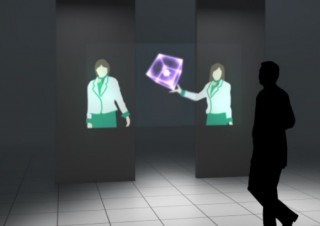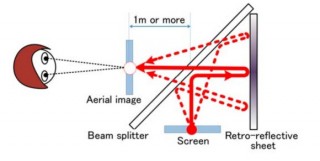Loading
Search
▼ The Future Is (almost) Now With Mitsubishi’s Proposed “Aerial Display” Hologram Tech
- Category:Other
Mitsubishi says it’s coming close to perfecting the kind of floating “hologram” images seen in sci-fi films—and it hopes to introduce the “Aerial Display” technology in time for the 2020 Tokyo Olympics.
The “holographic” performances of fictional android singer Hatsune Miku might seem like an amazing feat of future technology, but look more closely (not that you’d want to) at Miku’s performances — or live shows by the equally fictitious Gorillaz, if that’s more your flavor — and you might notice that these so-called “holograms” are actually just computer generated images being projected onto a thin, transparent screen.
Actual holograms as they’re depicted in science fiction — images that are literally projected onto thin air — are still an out-of-reach, nerdy pipe dream. Or so we thought until Mitsubishi suddenly announced they’d pretty much created the real deal and are planning to spring it on the public at the 2020 Tokyo Olympics.
The “holographic” performances of fictional android singer Hatsune Miku might seem like an amazing feat of future technology, but look more closely (not that you’d want to) at Miku’s performances — or live shows by the equally fictitious Gorillaz, if that’s more your flavor — and you might notice that these so-called “holograms” are actually just computer generated images being projected onto a thin, transparent screen.
Actual holograms as they’re depicted in science fiction — images that are literally projected onto thin air — are still an out-of-reach, nerdy pipe dream. Or so we thought until Mitsubishi suddenly announced they’d pretty much created the real deal and are planning to spring it on the public at the 2020 Tokyo Olympics.
The tech is actually deceptively simple when you get down to it. At its core, Mitsubishi’s “Aerial Display” is, essentially, a set of mirrors that reflect a projected image into open space. That sounds decidedly low-tech, but don’t count on being able to reproduce the effect with your dad’s 70s-era slide projector and your bathroom mirror. The key component required to make the whole thing work is something called a beam splitter, which Mitsubishi describes as, “an optical device that divides incoming light into reflected light and transmitted light.”
Additionally, a “retro-reflective sheet” is also required, but as far as we can tell, this is fancy science speak for, uh… a mirror (please direct geeky corrections to the comments section).
When these components work together, the result is a display that floats in mid-air, and Mitsubishi says the system is capable of projecting fairly large images — up to and possibly exceeding human size.
Surprisingly, Mitsubishi is just one of several companies around the world working on similar tech. There are other working prototypes out there, but a major problem with the tech has been that the images must be viewed from a particular angle to appear to the viewer as intended.
It’s unclear if Mitsubishi’s crack at the whole hologram thing will rectify this problem, but we suppose we’ll find out officially when Mitsubishi inevitably displays an enormous holographic Gundam onto the field at the 2020 Olympic opening ceremony.
Additionally, a “retro-reflective sheet” is also required, but as far as we can tell, this is fancy science speak for, uh… a mirror (please direct geeky corrections to the comments section).
When these components work together, the result is a display that floats in mid-air, and Mitsubishi says the system is capable of projecting fairly large images — up to and possibly exceeding human size.
Surprisingly, Mitsubishi is just one of several companies around the world working on similar tech. There are other working prototypes out there, but a major problem with the tech has been that the images must be viewed from a particular angle to appear to the viewer as intended.
It’s unclear if Mitsubishi’s crack at the whole hologram thing will rectify this problem, but we suppose we’ll find out officially when Mitsubishi inevitably displays an enormous holographic Gundam onto the field at the 2020 Olympic opening ceremony.
- February 23, 2016
- Comment (0)
- Trackback(0)



